We may not have the course you’re looking for. If you enquire or give us a call on 01344203999 and speak to our training experts, we may still be able to help with your training requirements.
We ensure quality, budget-alignment, and timely delivery by our expert instructors.
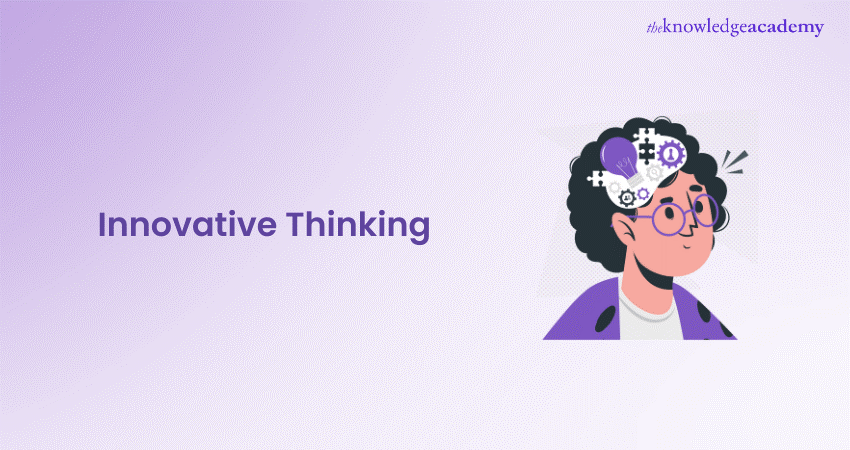
Innovative Thinking is the driving force behind progress and transformation across all sectors. It involves challenging conventional wisdom, embracing curiosity, and exploring diverse perspectives to generate novel ideas and solutions. By fostering a mindset that welcomes experimentation and values creativity, individuals and organisations can unlock their full potential for innovation.
In this blog, we’ll delve into the essence of Innovative Thinking and how it can be cultivated. We’ll explore real-world examples of groundbreaking innovations that have reshaped industries, from Airbnb’s disruption of the hospitality sector to Tesla’s revolution in automotive technology. Additionally, we’ll recommend inspiring movies and insightful books that can ignite your creative spark and provide valuable lessons on innovation.
Table of Contents
1) What is Innovative Thinking?
2) Strategies to Develop Your Innovative Thinking Skills
3) Examples of Innovative Thinking
4) How to Foster Innovative Thinking in Organisations?
5) Recommended Movies and Books on Innovative Thinking
6) Conclusion
What is Innovative Thinking?
Innovative Thinking is the ability to come up with new ideas, which must be original and different from traditional patterns. This means being unorthodox in one's approach to problem-solving and seeking new ways to solve complex issues.
Innovative Thinking provides benefits for the individual in increased growth of mindset, problem-solving, and adaptability and resiliency. Innovative Thinking unlocks potential for individuals and organisations to grow and achieve business objectives.
The innovative thinker can find new solutions to problems, be they to do with customer needs, sourcing materials, or the right human resources platform. Innovative Thinking enables us to discover solutions that haven't been found before.
What does Innovative Thinking look like? It comes in many forms. We often idealise innovative thinkers as quirky people with boundless curiosity, unruly hair, and a different way of looking at the world. In truth, innovative ideas come from thinkers applying a collection of innovative and creative thinking skills and ways of working that can be understood and learned. This intentional practice is gold in the workplace.
Why is Innovative Thinking So Important?
Gone are the days when a job could be considered permanent or when technology might not replace it. Technology develops so fast that almost every other day sees some new development in the job market. No field, from manual labour to a highly prestigious profession, remains out of the reach of AI and automation. As a result, employers value adaptability and problem-solving skills, often assessing them through creative thinking interview questions and answers to ensure candidates can thrive in an evolving job market. Let's look more closely at how different categories of jobs are affected and at the importance of Innovative Thinking for future job security.
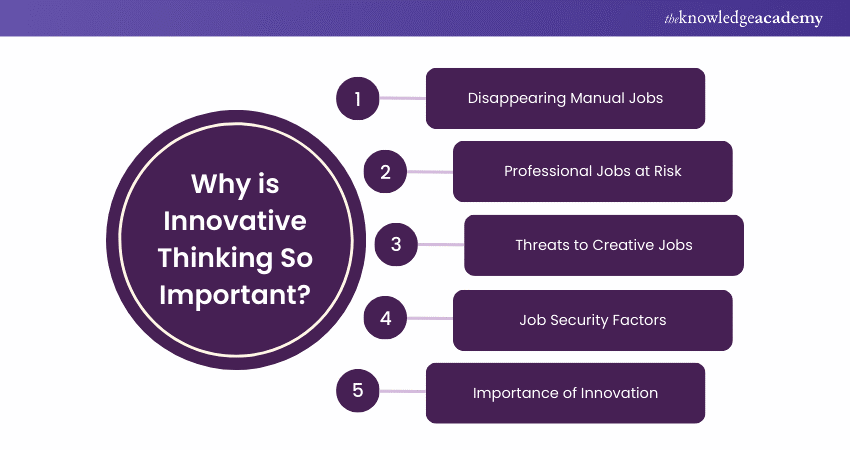
1) Disappearing Manual Jobs
This decline is picking up speed with the increasing use of automation and AI. For example, the trucking industry will soon face a crossroads because autonomous vehicles are going to render that line of work much more efficient and cheaper. Thus, this job is part of the greater trend that involves routine activity automation-automation that takes away jobs from millions of workers worldwide.
2) Professional Jobs at Risk
Even highly regarded professions, like doctors and attorneys, are in jeopardy as technology advances. Medical AI is bound to change the face of health in its development of the capacity to diagnose and administer treatment. Similarly, the leaps in AI technologies are about to revolutionise the legal profession by automating a great chunk of legal work and thus changing the way the law is practised.
3) Threats to Creative Jobs
AI innovations have increasingly affected creative positions, from the writing of newspaper articles to other forms of art. Because AI can create news articles, there is still a lot that must come from humans in the way of idea creation and editing to make sure works are creative and original. Yet other jobs entailing graphic creativity, including graphic design and video production, are not quite good candidates for automation. For this reason, human creativity is still sought after.
4) Job Security Factors
The key to job security exists in those roles that demand a blend of empathy, creativity, and problem-solving. It is all these skill factors that surround Innovative Thinking, which essentially is required for the individual who wants to be at an edge within their competitiveness, as well as for the company intending to prosper within the rapidly changing market.
5) Importance of Innovation
This is underlined by the accelerating speed of technological change. Amazon forced a change upon bookstores, Netflix killed Blockbuster, and the iPhone killed Nokia. Innovation thus seems to be the key to survival and growth. This can be further seen in the list of the world's most valued companies, as the most successful firms of the 21st century could be almost characterised all over by innovation.
Strategies to Develop Your Innovative Thinking Skills
The art of Innovative Thinking lies in the ability to unlock creative solutions. Curiosity, experimentation, and diverse perspectives can be fostered by a mindset that allows the generation of novel ideas and approaches. Let's explore a few effective ways to develop and sharpen your Innovative Thinking.
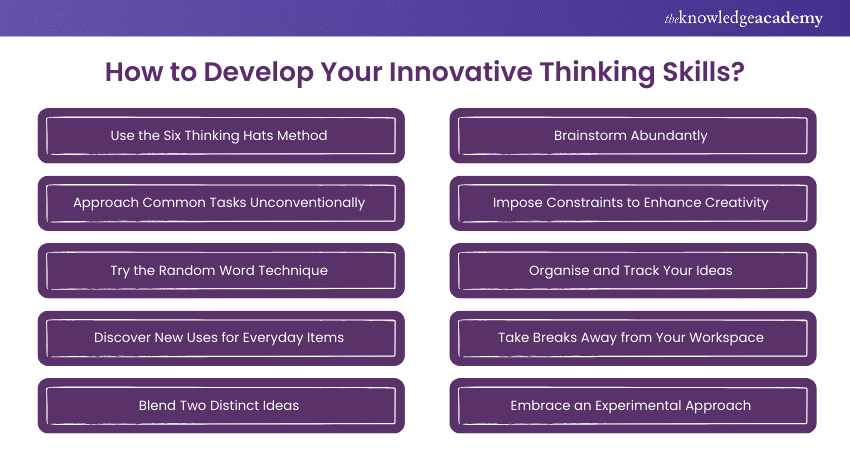
1) Use the Six Thinking Hats Method
The Six Thinking Hats system, designed by Edward de Bono, requires one to view a problem from many different perspectives. Each "hat" represents a mode of thinking: logical-white hat, emotional-red hat, creative-green hat, cautious-black hat, optimistic-yellow hat, and objective-blue hat.
By switching hats in an orderly fashion, one can examine a variety of angles and arrive at much more comprehensive solutions. It breaks down complex problems and allows for balanced decision-making.
2) Approach Common Tasks Unconventionally
Break the chain of routine regarding everyday tasks. If your day invariably starts with catching up on emails, try starting with something creative like brainstorming or doodling. It gets the brain ticking and opens different pathways for Innovative Thinking.
This gives flexibility to their thinking and maybe brings up unexpected insights when changing their approach in respect to everyday situations.
3) Try the Random Word Technique
In this technique, you are supposed to randomly pick a word and then associate it with your problem by coming up with new ideas. In so doing, sometimes these unexpected connections make for a fresh perspective.
For instance, if you are working on some marketing campaign and the random word happens to be "ocean," then you can let your imagination soar with depth, exploration, or tranquillity. This method helps in lateral thinking and can bring you out of the vicious circle of conventional ways of thinking.
4) Discover New Uses for Everyday Items
Acquire the new challenge in seeking alternative uses for everything surrounding you. Such activity will develop your creative and problem-solving skills much more promptly.
Take a paper clip as an example: besides being used to hold the papers together, it can be transformed into a kind of zipper pull, into a stand for your phone, or even into a tiny sculpture. Having such practice, you will open your eyes before unnoticeable things and will teach yourself how to be resourceful in any situation.
5) Blend Two Distinct Ideas
Mix and match concepts coming from two different areas. Sometimes this process is referred to as "conceptual blending". It can result in innovative solutions. Think about how the combination of a telephone and camera gave birth to completely new ways of capturing and sharing life's moments. You will have the opportunity to develop a very special kind of product or solution with the blending of two different ideas.
Unlock your sales potential! Our expert-led Sales Training helps you increase conversions and exceed targets. Start your journey now!
6) Brainstorm Abundantly
Whenever you brainstorm, initially, it is better to prefer quantity over quality. Just jot down some ideas, not evaluating them. That would help dig out hidden gems and gain an open-minded attitude toward creativity. The more ideas one can generate, the better the chances of discovering a creative solution.
7) Impose Constraints to Enhance Creativity
Sometimes, constraints can allow creativity to flourish. Impose certain constraints on the project, like a time limit or a budget ceiling. These constraints will have you thinking more resourcefully and looking for new ways of doing something. Constraints can spark creativity since sometimes forcing yourself out of your own box is exactly what you need.
8) Organise and Track Your Ideas
Keep a special notebook or online tool where you jot down ideas. Revisit the list regularly, looking for patterns and inter-relationships between those ideas. In that way, no idea is ever lost, and you can build upon prior ideas. You can come back and evolve ideas over time by tracking them, coming up with even more robust and creative results.
9) Take Breaks Away from Your Workspace
A change of scenery can clear your mind and get the ideas flowing. Take a walk, go to a museum, or just sit in a different space. Sometimes, taking a break is all you need to open space in your mind for creative insights. A shift in perspective can bring forth new ways of considering the problem.
10) Embrace an Experimental Approach
Be willing to try new things, though at risk of failure. View trying as an opportunity to learn. This attitude will lead to continuous improvement and a culture of innovation. You will discover new methodologies and ideas that will be key to your breakthrough innovations through experiments.
Transform your ideas into innovation! Join our Innovative Thinking Training and lead with creativity - Register now
Examples of Innovative Thinking
Innovative Thinking drives progress and transforms industries by fostering creativity and problem-solving. By embracing curiosity and diverse perspectives, individuals and organisations can unlock groundbreaking ideas and solutions. Implementing an Innovation Framework further amplifies this process, fostering an environment that nurtures creativity and ingenuity. Let’s delve into some real-world examples that showcase the power of Innovative Thinking.
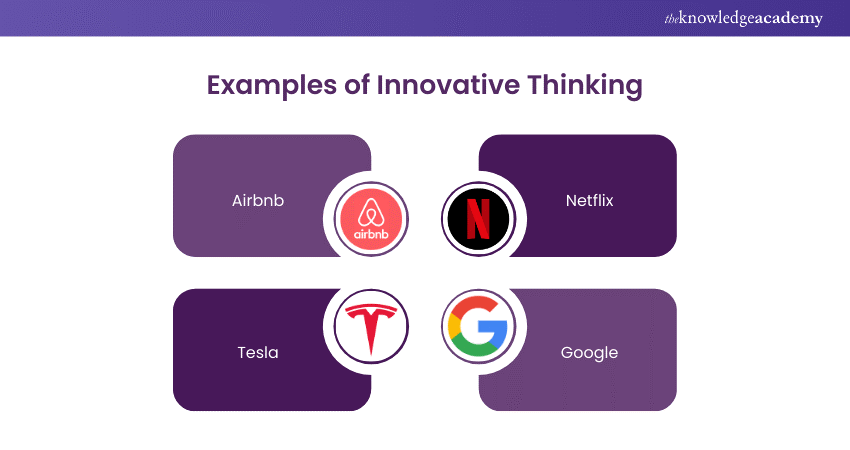
1) Airbnb: The founders of Airbnb changed the hospitality industry by creating a website that would allow individuals to rent their homes or a spare room to travellers. Indeed, it gave a different travelling experience; however, it also gave the homeowner one more means of receiving extra money. This idea of a shared economy really did change things and can help make travel more budget-friendly and customised.
2) Tesla: It was not just making electric cars, but Elon Musk's vision for Tesla had been to bring a revolution in the automobile sector. Tesla's path-breaking stride includes innovation in battery technology, driverless cars, and direct sale to customers. Their commitment to sustainability and state-of-the-art technologies set the benchmark for all others in the industry.
3) Netflix: Netflix started as a subscription-based DVD rental service, shifted to streaming media, and then further shifted to producing original content. This transition also changed the game of how people consume media, not just disrupting the conventional ways of television and film. With data-driven content creation and personalised recommendations, Netflix has managed to always be on the bleeding edge of the entertainment business.
4) Google: From its innovative approach to search algorithms and advertising models to its workplace culture, Google is an original by nature. Innovative projects like Google Maps, Google Earth, and driverless cars-Waymo-demonstrate a commitment to the advancement of technology, alongside systems like Android Auto, which further enhance the in-car experience with smart, AI-powered features. The company culture of encouraging employees to invest 20% of their work time in passion projects led to numerous breakthrough innovations.
How to Foster Innovative Thinking in Organisations?
An organisation’s ability to foster Innovative Thinking and problem-solving skills hinges on its openness to employees finding unusual connections between their work and that of others. This begins with hiring practices; without a diverse team, inspiring innovation is challenging.
Embracing diverse backgrounds encourages the combination of disparate ideas, pushing the organisation toward Innovative Thinking. Companies that have historically embraced workforce diversity often enjoy higher levels of creative thinking and innovative ideas. These companies sustain success by continually identifying the best ideas through dedicated practices focused on Innovative Thinking.
Emotions indicate unmet needs, and intuition senses our complex, vague reality. Intuition allows us to unconsciously see patterns that our rational minds might miss. Both emotions and intuition play roles in all stages of mindset, though not always consciously or officially recognised. The more you consciously and mindfully incorporate emotions and intuition into structured decision-making processes, the more often surprising outcomes emerge.
Understanding the complementary nature of emotions and intuition helps managers obtain the right mindset for encouraging innovation. Innovative thinkers generate ideas best when supervisors create an environment designed to foster innovation. This requires deliberate action from those in charge. While we might believe in the spark of inspiration, the creative process demands a particular environment to flourish.
To build an environment that promotes innovative ideas, consider the following:
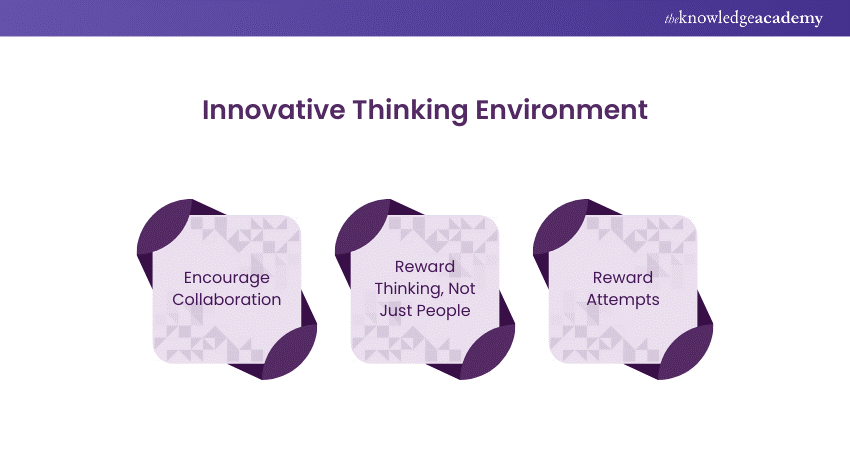
1) Encourage Collaboration: Create spaces where people from different teams can meet. Ensure your company has a creative operating system willing to leave the status quo behind. Incorporate Innovative Thinking into usual practices and recognise innovative thinkers on your staff.
2) Reward Thinking, Not Just People: Creative thinking is often the first step toward new ideas, even if not immediately profitable. Redefine “failure” and “success” to reflect a dedication to Innovative Thinking.
3) Reward Attempts: A creative mindset won’t thrive in an environment fixated on outdated notions of success. Reward the measured efforts of innovative thinkers to try something new. Encourage more Innovative Thinking without discouraging failure.
Recommended Movies and Books on Innovative Thinking
Exploring movies and Design Thinking Books on Innovative Thinking can boost your creativity and provide valuable insights into the minds of great innovators. These recommendations offer a blend of real-world examples and theoretical frameworks to inspi
1) Movies
a) The Social Network: This popular film tells the story of the rise of Facebook and shows new ideas and challenges faced by Mark Zuckerberg and his team. It's a very nice example how an idea could be brought onto the global map from a small one.
b) Moneyball: It is a true story of how Innovative Thinking in analytics changed baseball. Gripping to watch, to understand methods applied in unconventional ways to achieve groundbreaking performance.
c) Inception: Although fictional, the philosophy of this movie-great powers of the mind and creativity-challenges viewers to think out-of-the-box and consider the endless possibilities of Innovative Thinking.
2) Books
a) The Innovator's Dilemma by Clayton Christensen: This classic book, now in second edition, looks at why companies that succeed often are not successful at innovating, and conversely how companies can avoid meeting this fate. It is a must-read for any person who wants to understand the dynamics of innovation.
b) Creative Confidence by Tom Kelley and David Kelley: This is by the founders of IDEO. This gives insight into unleashing your creative potential and fostering a culture of innovation.
c) Zero to One by Peter Thiel: The book offers a unique perspective into creating innovative startups, or as his words go, ways of creating the future. Thiel insists on thinking differently and finding unique solutions for any problem.
d) The Lean Startup by Eric Ries: This revolutionary book stands as a guide toward new ways in the development of businesses by emphasising rapid prototyping, validated learning, and iterative product releases. Useful contribution for entrepreneurs and innovators.
Unlock the secrets to effective meetings. Elevate your leadership and communication skills with our Meeting Skills Training – Join now!
Conclusion
Innovative Thinking is a powerful tool that can drive progress and transform industries. By embracing curiosity, diverse perspectives, and a willingness to experiment, individuals and organisations can unlock groundbreaking ideas and solutions. Understanding the different Types of Innovation can further enhance this process, helping individuals approach challenges with fresh, strategic perspectives.
Master the art of sales! Register for our Sales Management Training and learn how to lead, motivate, and drive results effectively.
Frequently Asked Questions
What is an Innovative Mindset?

An innovative mindset is a way of thinking that encourages curiosity, creativity, and taking risks. It’s about seeing things differently, thinking outside the box, and being open to change and new ideas to create unique solutions.
Can Innovative Thinking be Trained?

Innovative Thinking can be learned. By fostering traits like curiosity, open-mindedness, and resilience, people can become better problem-solvers. Techniques like brainstorming, design thinking, and promoting a culture of experimentation can help build and refine these skills.
What are the Other Resources and Offers Provided by The Knowledge Academy?

The Knowledge Academy takes global learning to new heights, offering over 3,000 online courses across 490+ locations in 190+ countries. This expansive reach ensures accessibility and convenience for learners worldwide.
Alongside our diverse Online Course Catalogue, encompassing 19 major categories, we go the extra mile by providing a plethora of free educational Online Resources like News updates, Blogs, videos, webinars, and interview questions. Tailoring learning experiences further, professionals can maximise value with customisable Course Bundles of TKA.
What is The Knowledge Pass, and How Does it Work?

The Knowledge Academy’s Knowledge Pass, a prepaid voucher, adds another layer of flexibility, allowing course bookings over a 12-month period. Join us on a journey where education knows no bounds.
What are the Related Courses and Blogs Provided by The Knowledge Academy?

The Knowledge Academy offers various Sales Courses, including the Sales Negotiation Training, the Sales Analytics Training, and the Online Sales Training. These courses cater to different skill levels, providing comprehensive insights into Operations Management.
Our Business Skills Blogs cover a range of topics related to Innovative Thinking, offering valuable resources, best practices, and industry insights. Whether you are a beginner or looking to advance your Business Skills, The Knowledge Academy's diverse courses and informative blogs have got you covered.
Upcoming Business Skills Resources Batches & Dates
Date
 Retail Fundamentals Training
Retail Fundamentals Training
Fri 4th Apr 2025
Fri 27th Jun 2025
Fri 29th Aug 2025
Fri 24th Oct 2025
Fri 5th Dec 2025






 Top Rated Course
Top Rated Course



 If you wish to make any changes to your course, please
If you wish to make any changes to your course, please


